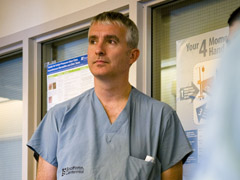Too Big To Ignore
By Jim Oldfield
Implementing an evidence-based health care innovation, even in the best circumstances, is often like solving a puzzle—crafted strategies are scuppered; unintended consequences abound.
In the more complex case of selective decontamination of the digestive tract (SDD), this process known as knowledge transfer is akin to something larger and more intractable.
"Selective decontamination of the digestive tract is the elephant in the room of critical care medicine," says Dr. Brian Cuthbertson, a scientist at Sunnybrook Research Institute (SRI) and chief of critical care medicine at Sunnybrook.
It's huge, in that a large body of evidence suggests it could save thousands of lives. But it's largely ignored: clinicians have been aware of its potential for decades but have not implemented it.
Selective decontamination of the digestive tract involves giving an intravenous round of antibiotics and applying antibiotic paste to patients in intensive care. Dozens of randomized controlled trials have shown it curbs hospital-acquired infection rates, and researchers estimate it could reduce mortality in critically ill patients—who are especially prone to infection—by 4% to 6%.
So why are only a small number of critical care units around the world practising it? That's the question Cuthbertson is seeking to answer.
Uncertainties, Concerns and Other Barriers to Implementing SDD
Funded by a $200,000 grant from the Canadian Institutes of Health Research (CIHR)—one of four the agency awarded to scientists at SRI in its spring 2010 operating funds competition—Cuthbertson will examine the reasons Canadian clinicians have not adopted SDD, the challenges to implementing it and whether more evidence is required for widespread acceptance of the procedure.
"When we talk to health psychologists who study professional behaviour, they tell us, 'You've got a lot of evidence, but there are barriers—your clinicians are not implementing this intervention because they don't find it intuitive, and they're worried,'" says Cuthbertson.
Mainly, they're worried about antibiotic resistance, which Cuthbertson says is a genuine concern: there's not enough evidence showing what will happen to the microbiological environments of intensive care units or hospitals on adoption of the procedure. And yet, he notes, numerous studies stretching back to the 1980s point strongly toward a benefit.
"This is a coming-of-age issue for critical care medicine. It's just been too difficult to grapple with, in our first 20 to 30 years as a specialty," he says. "But it has the potential to provide more benefit than any other intervention in critical care."
Collaborating to Reach a Consensus
The idea for the study came to Cuthbertson two years ago, when he was based at the University of Aberdeen in the United Kingdom. He presented it to colleagues there, then spoke with members of the Canadian Critical Care Trials Group and researchers in Australia and New Zealand. They were all thinking the same thing. "We finally decided, 'It's time to grasp this nettle and deal with the issue once and for all,'" he says.
A collaborative effort led by Cuthbertson is now underway in all three zones, involving world leaders in critical care, methodologists, health psychologists, sociologists and statisticians.
Cuthbertson expects the outcome of the CIHR study will point to a consensus on one of three ways forward: one, gather more evidence that SDD saves lives by conducting an enormous trial in which entire critical care units—not just individual patients—are randomized; two, give up and move on, because SDD is too risky, expensive and resource-depleting; or three, conduct an implementation study, meaning clinicians agree that SDD should be done but they are uncertain how to implement it.
"It will be really interesting to see the results," says Cuthbertson. "It's a fascinating research area that enthralls most who come to it."
Other CIHR Spring 2010 Operating Grant Recipients
- Dr. Sandra Black, $203,012 over three years: "Towards functional imaging biomarkers of Alzheimer's disease."
- Dr. James Carlyle, $677,345 over five years: "NK cell receptor-ligand interactions in recognition of tumour cells and infected targets."
- Dr. Jacques Lee, $194,094 over 18 months: "A study to validate the Paramedics assessing Elders at Risk of Independence Loss (PERIL) prediction rule."






